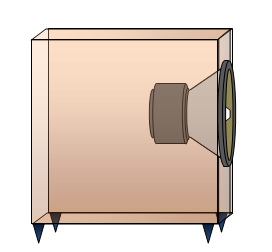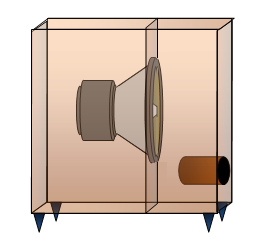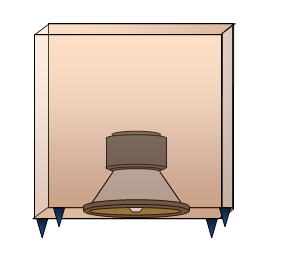4. Housings - www.hifilounge.eu
Main menu:
- Home
- General
-
Speakers
- Basics
- Speakers
- Headphones
- Subwoofer
- Elektronics
- Surround
- Photography
- Infos
4. Housings
Speakers > Subwoofer
Various types of low bass loudspeakers have established themselves on the market. In the following, some variants are shown - without claiming to be complete.
A freely suspended bass driver that moves air cannot produce any bass. If it moves air, air flows from behind. This "afterbass effect" does not occur with the high tones because of the extremely fast movements of the diaphragms; with low tones you react to this by screwing the chassis into a box. In the simplest case this is the closed loudspeaker.

Figure 1: Closed subwoofer
Enclosed speakers: An airtight enclosure without holes with a speaker chassis. In small rooms, where the wavelength of the bass is longer than the length of the room, the usual wave pattern does not fit anymore. Here, pressure chamber conditions prevail. You can imagine it more like the pressure generation in an air pump. Since the air trapped in the closed cabinet cannot escape and contribute to pressure equalisation, such speakers often work very well in small rooms - they can produce very deep bass. This effect is often exploited in vehicle sound reinforcement systems, but when windows are open, the bass becomes much weaker.
A loudspeaker that is linear downwards under free field conditions will become louder here by 12dB downwards per octave. A closed cabinet below the resonance frequency has an advantage here, your 12dB drop below this frequency correlates exactly with the rise due to the pressure chamber effect, which in practice results in a linear frequency response down to (theoretically) 0 Hz (if your room and cabinet are absolutely airtight). It should be noted that compared to very low bass most living rooms are considered small, especially small and closed rooms are also cars from the car hifi's point of view. Further advantages are a good group delay and good impulse behaviour, unfortunately some closed cabinets tend to compress at high levels.

Figure 2: Bass reflex
Bass reflex: By now almost standard. In contrast to a closed cabinet; if the sound that is not emitted towards the living room is not killed, it is let out through a tube. Cabinet volume and length of the reflex tubes should be adjusted to the driver in question in advance to avoid runtime problems. Also the resonances that occur especially with deep bass should be considered carefully. The reward is a shift of the resonance frequency downwards, under some conditions more depth and higher power handling. like closed subwoofers - as long as the pressure chamber model is not used. As a clear disadvantage: taking the reflex opening into account increases the group delay, furthermore "booming" phenomena are stronger than with closed cabinets. In the past reflex speakers were considered "imprecisely booming party speakers", but thanks to computer simulation today one can get a lot out of this principle.
Bass radiator: instead of a reflex port a passive diaphragm is used. This reduces the efficiency, which can be compensated by a stronger power amplifier, but prevents airflow noise. Theoretically, a good design can make the bass noticeably cleaner. Unfortunately, the impulse response suffers under this variant.

Figure4: Bandpass Subwoofer
Bandpass: Actually nothing more than enclosing a bass reflex cabinet in another reflex cabinet. No diaphragm is visible from the outside, however, there is a hole at one point of the cabinet.
The subwoofer can only be used very narrowly in the area of the resonator resonance of the reflex tube, above and below resonance the subwoofer is useless - hence the name bandpass. From an acoustic point of view, the narrow-band subwoofer can be operated without additional electrical crossovers if the resonance frequency is tuned correctly. If an electrical relief of the subwoofer is desired, the filter is of course still useful.
A disadvantage for home cinema operation is the limited low bass. In addition, there are delay times, bad impulse behaviour and, with sloppy implementation, a booming muddy bass. This solution is very popular in car hifi communities and in the very-low-budget sector - in professional sound reinforcement systems at rock concerts where bass guitars and hip-hop kick basses are expected as the lowest tones, but real low bass like in home cinema is missing, band passes are also found.
Due to the problems with group runtimes, musical band passes for conventional hifi are rather rare.

Figure 4: Downfire subwoofer
Most subwoofers are front-fire subwoofers, or direct radiators: the bass is radiated forward. Due to the large wavelengths in the bass, the subwoofer acts as a spherical radiator, so the drivers can also be mounted on the bottom of the subwoofer. Corresponding subwoofers are called downfire subwoofers.
One possible reason for this arrangement is the optics - the second reason is the room modes. Near the wall the room modes have their pressure maximum. A subwoofer that excites the room near the floor will excite the vertical room modes to their maximum - the result is more booming at the same supplied amplifier power. Many hifi freaks generally reject downfire subwoofers on the grounds of "booming muddy bass", others prefer these subwoofers.
Due to the vertical movement of the diaphragm the floor is maximally excited by downfire subwoofers. If you live in an Albau with rotten wooden floorboards, you should agree on a right of return when buying the subwoofer. The same applies to residents of an apartment building, after all more structure-borne sound is emitted into the floor than with front-fire subwoofers. Downfire subwoofers are often placed on a sound-reflecting granite plate which is decoupled downwards by soft rubber absorbers.
For the sake of completeness we would like to mention body shakers. Bodyshakers are miniwoofers that are attached to the seating furniture. They are supposed to transmit low-frequency sound when the tree-people stomp around in e.g. "Lord of the Rings" even more directly and perceptibly to the people. The demand for perfect reproduction of a jazz recording is probably less given here. However, home cinema fans can have something like this demonstrated to them, with rubber absorbers under the seating furniture, this allows a relatively neighbour-friendly low bass orgy up to a certain limit.